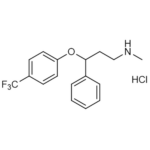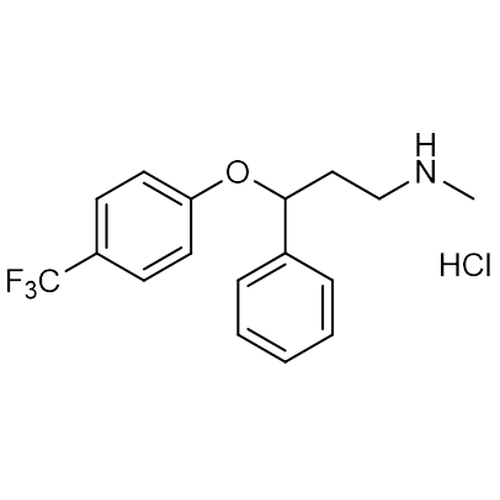| Product Name | Fluoxetine HCl |
| Description |
Serotonin reuptake inhibitor |
| Purity | ≥98% (HPLC); NMR (Conforms) |
| CAS No. | 56296-78-7 |
| Molecular Formula | C17H18F3NO • HCl |
| Molecular Weight | 345.8 |
| Field of Use | Not for use in humans. Not for use in diagnostics or therapeutics. For in vitro research use only. |
Properties
| Storage Temperature | -20ºC |
| Shipping Temperature | Shipped Ambient |
| Product Type | Inhibitor |
| Solubility | May be dissolved in DMSO (35 mg/ml); or water (4 mg/ml) |
| Source | Synthetic |
| Appearance | White powder |
| SMILES | CNCCC(C1=CC=CC=C1)OC2=CC=C(C=C2)C(F)(F)F.Cl |
| InChI | InChI=1S/C17H18F3NO.ClH/c1-21-12-11-16(13-5-3-2-4-6-13)22-15-9-7-14(8-10-15)17(18,19)20;/h2-10,16,21H,11-12H2,1H3;1H |
| InChIKey | GIYXAJPCNFJEHY-UHFFFAOYSA-N |
| Safety Phrases |
Classification: Danger GHS Hazard Statements, H302 (98%): Harmful if swallowed [Warning Acute toxicity, oral] H315 (92.1%): Causes skin irritation [Warning Skin corrosion/irritation] H318 (96%): Causes serious eye damage [Danger Serious eye damage/eye irritation] H400 (58.4%): Very toxic to aquatic life [Warning Hazardous to the aquatic environment, acute hazard] Precautionary Statement Codes,: P264, P264+P265, P270, P273, P280, P301+P317, P302+P352, P305+P354+P338, P317, P321, P330, P332+P317, P362+P364, P391, and P501 |
| Cite This Product | Fluoxetine HCl (StressMarq Biosciences Inc., Victoria BC CANADA, Catalog # SIH-631) |
Biological Description
| Alternative Names | (±)-N-Methyl-γ-[4-(trifluoromethyl)phenoxy]benzenepropanamine hydrochloride; LY-110,140 |
| Research Areas | Neurodegeneration, Neuroscience, Neurotransmission, Stem Cells, Neural Stem Cells |
| PubChem ID | 62857 |
| Scientific Background | Fluoxetine HCl is a selective serotonin reuptake inhibitor (SSRI) widely used as an antidepressant. It exhibits high selectivity for the serotonin transporter and has demonstrated neuroprotective and neurogenic effects. Fluoxetine enhances neuronal precursor proliferation and differentiation, reduces neuroinflammation, and improves outcomes in models of brain injury and neurodegeneration. It is also being explored for its potential in autism spectrum disorders and cognitive enhancement. |
| References |
1. M Tatsumi et al. Eur. J. Pharmacol. 1997 340:249 2. P Benfield et al. Drugs 1986 32:481 3. A Benvenuto et al. Brain Dev. 2013 35:119 4. FY Liu et al. J. Neuroinflammation 2018 15:347 5. EA Chang et al. Int. J. Dev. Biol. 2010 54:707 |



Reviews
There are no reviews yet.